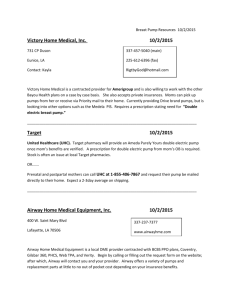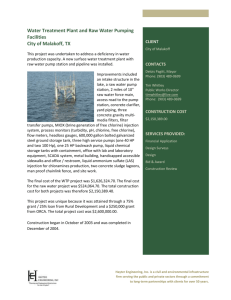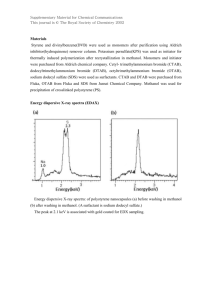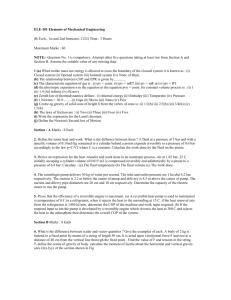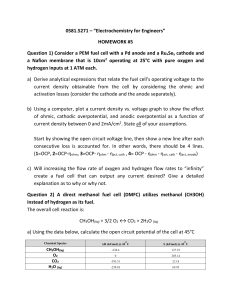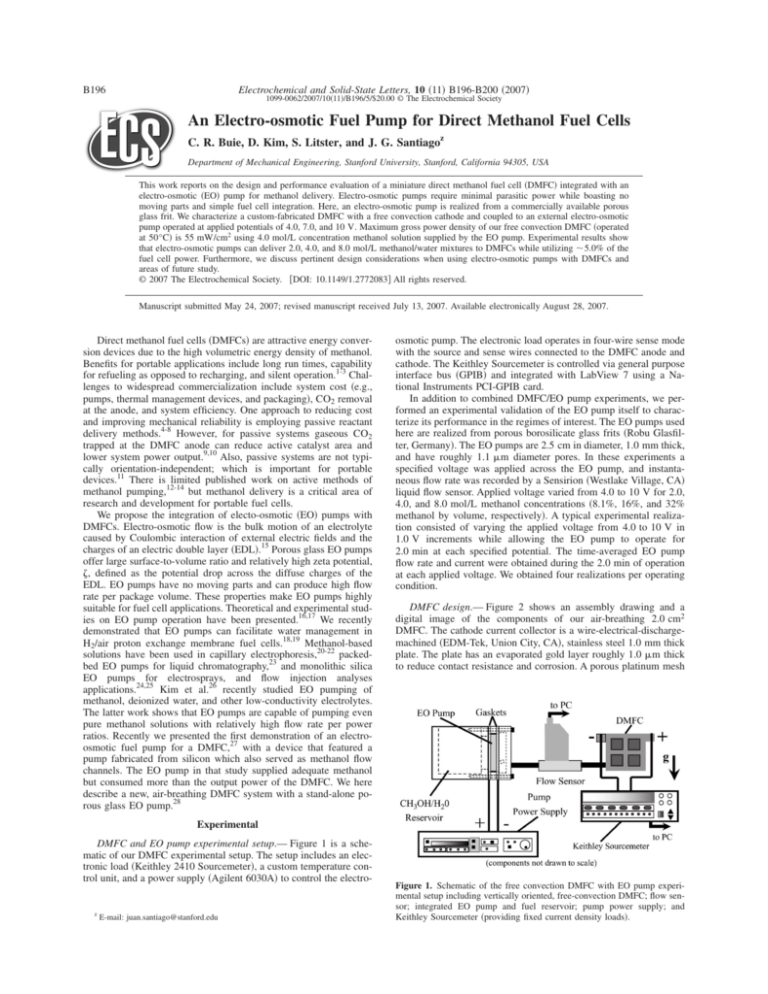
Electrochemical and Solid-State Letters, 10 共11兲 B196-B200 共2007兲
B196
1099-0062/2007/10共11兲/B196/5/$20.00 © The Electrochemical Society
An Electro-osmotic Fuel Pump for Direct Methanol Fuel Cells
C. R. Buie, D. Kim, S. Litster, and J. G. Santiagoz
Department of Mechanical Engineering, Stanford University, Stanford, California 94305, USA
This work reports on the design and performance evaluation of a miniature direct methanol fuel cell 共DMFC兲 integrated with an
electro-osmotic 共EO兲 pump for methanol delivery. Electro-osmotic pumps require minimal parasitic power while boasting no
moving parts and simple fuel cell integration. Here, an electro-osmotic pump is realized from a commercially available porous
glass frit. We characterize a custom-fabricated DMFC with a free convection cathode and coupled to an external electro-osmotic
pump operated at applied potentials of 4.0, 7.0, and 10 V. Maximum gross power density of our free convection DMFC 共operated
at 50°C兲 is 55 mW/cm2 using 4.0 mol/L concentration methanol solution supplied by the EO pump. Experimental results show
that electro-osmotic pumps can deliver 2.0, 4.0, and 8.0 mol/L methanol/water mixtures to DMFCs while utilizing ⬃5.0% of the
fuel cell power. Furthermore, we discuss pertinent design considerations when using electro-osmotic pumps with DMFCs and
areas of future study.
© 2007 The Electrochemical Society. 关DOI: 10.1149/1.2772083兴 All rights reserved.
Manuscript submitted May 24, 2007; revised manuscript received July 13, 2007. Available electronically August 28, 2007.
Direct methanol fuel cells 共DMFCs兲 are attractive energy conversion devices due to the high volumetric energy density of methanol.
Benefits for portable applications include long run times, capability
for refueling as opposed to recharging, and silent operation.1-3 Challenges to widespread commercialization include system cost 共e.g.,
pumps, thermal management devices, and packaging兲, CO2 removal
at the anode, and system efficiency. One approach to reducing cost
and improving mechanical reliability is employing passive reactant
delivery methods.4-8 However, for passive systems gaseous CO2
trapped at the DMFC anode can reduce active catalyst area and
lower system power output.9,10 Also, passive systems are not typically orientation-independent; which is important for portable
devices.11 There is limited published work on active methods of
methanol pumping,12-14 but methanol delivery is a critical area of
research and development for portable fuel cells.
We propose the integration of electo-osmotic 共EO兲 pumps with
DMFCs. Electro-osmotic flow is the bulk motion of an electrolyte
caused by Coulombic interaction of external electric fields and the
charges of an electric double layer 共EDL兲.15 Porous glass EO pumps
offer large surface-to-volume ratio and relatively high zeta potential,
, defined as the potential drop across the diffuse charges of the
EDL. EO pumps have no moving parts and can produce high flow
rate per package volume. These properties make EO pumps highly
suitable for fuel cell applications. Theoretical and experimental studies on EO pump operation have been presented.16,17 We recently
demonstrated that EO pumps can facilitate water management in
H2/air proton exchange membrane fuel cells.18,19 Methanol-based
solutions have been used in capillary electrophoresis,20-22 packedbed EO pumps for liquid chromatography,23 and monolithic silica
EO pumps for electrosprays, and flow injection analyses
applications.24,25 Kim et al.26 recently studied EO pumping of
methanol, deionized water, and other low-conductivity electrolytes.
The latter work shows that EO pumps are capable of pumping even
pure methanol solutions with relatively high flow rate per power
ratios. Recently we presented the first demonstration of an electroosmotic fuel pump for a DMFC,27 with a device that featured a
pump fabricated from silicon which also served as methanol flow
channels. The EO pump in that study supplied adequate methanol
but consumed more than the output power of the DMFC. We here
describe a new, air-breathing DMFC system with a stand-alone porous glass EO pump.28
osmotic pump. The electronic load operates in four-wire sense mode
with the source and sense wires connected to the DMFC anode and
cathode. The Keithley Sourcemeter is controlled via general purpose
interface bus 共GPIB兲 and integrated with LabView 7 using a National Instruments PCI-GPIB card.
In addition to combined DMFC/EO pump experiments, we performed an experimental validation of the EO pump itself to characterize its performance in the regimes of interest. The EO pumps used
here are realized from porous borosilicate glass frits 共Robu Glasfilter, Germany兲. The EO pumps are 2.5 cm in diameter, 1.0 mm thick,
and have roughly 1.1 m diameter pores. In these experiments a
specified voltage was applied across the EO pump, and instantaneous flow rate was recorded by a Sensirion 共Westlake Village, CA兲
liquid flow sensor. Applied voltage varied from 4.0 to 10 V for 2.0,
4.0, and 8.0 mol/L methanol concentrations 共8.1%, 16%, and 32%
methanol by volume, respectively兲. A typical experimental realization consisted of varying the applied voltage from 4.0 to 10 V in
1.0 V increments while allowing the EO pump to operate for
2.0 min at each specified potential. The time-averaged EO pump
flow rate and current were obtained during the 2.0 min of operation
at each applied voltage. We obtained four realizations per operating
condition.
DMFC design.— Figure 2 shows an assembly drawing and a
digital image of the components of our air-breathing 2.0 cm2
DMFC. The cathode current collector is a wire-electrical-dischargemachined 共EDM-Tek, Union City, CA兲, stainless steel 1.0 mm thick
plate. The plate has an evaporated gold layer roughly 1.0 m thick
to reduce contact resistance and corrosion. A porous platinum mesh
Experimental
DMFC and EO pump experimental setup.— Figure 1 is a schematic of our DMFC experimental setup. The setup includes an electronic load 共Keithley 2410 Sourcemeter兲, a custom temperature control unit, and a power supply 共Agilent 6030A兲 to control the electro-
z
E-mail: juan.santiago@stanford.edu
Figure 1. Schematic of the free convection DMFC with EO pump experimental setup including vertically oriented, free-convection DMFC; flow sensor; integrated EO pump and fuel reservoir; pump power supply; and
Keithley Sourcemeter 共providing fixed current density loads兲.
Electrochemical and Solid-State Letters, 10 共11兲 B196-B200 共2007兲
B197
Figure 3. Polarization curves for 2.0 cm2 DMFCs with nine-, three-, and
single-channel anodes. The DMFC operates at room temperature with a
60 L/min 4.0 mol/L methanol flow rate supplied by syringe pump in each
case. Maximum power densities of the nine-, three-, and single-channel designs are respectively 9.2, 17, and 19 mW/cm2.
Figure 2. Assembly drawing 共a兲 and digital image 共b兲 of the air-breathing
DMFC used in this study. As shown in 共a兲, fuel flows from the EO pump,
through the back plate and anode current collector, and reacts at the MEA.
The pressure difference generated by the EO pump drives fuel, CO2, and
water through the system and out of the outlet.
共Goodfellow Cambridge Limited, Cambridge, U.K.兲 was layered on
the cathode to reduce ohmic losses due to lateral electron conduction
in the gas diffusion layer 共GDL兲.
The membrane electrode assembly 共MEA兲 共BCS Fuel Cells, Inc.,
Bryan, TX兲 consisted of a 180 m thick Nafion membrane 共Nafion
117兲 with 350 m thick carbon cloth GDLs. The Pt/Ru anode catalyst and Pt cathode catalyst loadings were 4.0 and 2.0 mg/cm2, respectively. Pt/Ru catalyst was used to improve the relatively slow
reaction kinetics of methanol oxidation at the anode. The anode flow
field was a graphite plate with end-milled 750 m wide by 500 m
deep flow channels. The anode current collector was gold-plated
copper machined inhouse to fit the structure. The temperature of the
cell was regulated at the anode back plate, which included an embedded type K thermocouple and resistive heating element.
Several options are available in the design of fuel cell flow fields
and each places unique demands on pumping media. These include
共but are not limited to兲 parallel channels, serpentine channels, combination parallel/serpentine channels, and interdigitated flow
fields.29 Frictional losses translate into higher pressure loads and
subsequently, higher EO pump power. We evaluated three anode
flow field designs with parallel 共nine-channel兲, parallel/serpentine
共three-channel兲, and serpentine channels 共one-channel兲. Figure 3
shows room-temperature polarization data for the three flow channel
designs fed 4.0 mol/L methanol at 60 L/min using a syringe
pump. For this 2.0 cm2 DMFC, 60 L/min corresponds to an anode
stoichiometric flow ratio of roughly 12 at 100 mA/cm2. As shown,
the one-channel design displays the highest DMFC potential for a
given current. The maximum power of the one-channel design is
10% higher 共19 vs 17 mW/cm2兲 than the three-channel design. The
higher power density of the one-channel design is due to its higher
methanol velocity, resulting in improved CO2 removal at the
anode.30 Given the pressure capability of our pump,28 we chose the
one-channel design, and all of the data below is for this one-channel
design.
Results
Electro-osmotic pump evaluation.— Figure 4 shows measurements summarizing the electro-osmotic pump characterization.
Here, we operate the EO pump in the absence of the DMFC 共i.e., no
pressure load兲. Figure 4a shows maximum pump flow rate as a
function of applied voltage for 2.0, 4.0, and 8.0 mol/L methanol
solutions. Equations 1 and 2 give the relationship between maximum EO pump flow rate and applied voltage
Qmax = −
AEOVeff
f
L
Veff = Vapp − Vdec − 2RAIEO
关1兴
关2兴
In Eq. 1, and are EO pump porosity and tortuosity, respectively,
is permittivity of the working fluid, is zeta potential, AEO is the
EO pump area, Veff is the effective potential across the pumping
substrate, is viscosity of the working fluid, and L is pump thickness. The factor f is a nondimensional parameter determined from
solutions to the nonlinear Poisson Boltzmann equation describing
the EDLs. In Eq. 2, Vapp is applied voltage, Vdec is decomposition
potential 共the minimum voltage to initiate electrolysis兲, RA is resistance of the working fluid between the pump and electrode, and IEO
is the EO pump current.
B198
Electrochemical and Solid-State Letters, 10 共11兲 B196-B200 共2007兲
Table I. Maximum EO pump pressure measurements.
CCH3OH
共mol/L兲
Vapp
共V兲
Veff 共est.兲
共V兲
⌬pmax 共Pa兲
2.0
4.0
7.0
10
0.71
2.8
4.5
360 ± 26
980 ± 250
1300 ± 150
4.0
4.0
7.0
10
1.1
3.6
5.8
390 ± 18
720 ± 26
1100 ± 120
8.0
4.0
7.0
10
1.2
3.4
5.4
340 ± 28
640 ± 100
1100 ± 84
rate 共Qmax兲 divided by the pump power 共 Pmax兲 consumption for
each of the cases shown in Fig. 4a. Equation 3 gives the theoretical
formulation of Qmax /Pmax
g
Qmax
=−
Pmax
Vapp⬁
Figure 4. EO pump flow rate 共a兲 and flow rate per power 共b兲 vs applied
voltage. As expected, maximum flow rate is a linear function of applied
voltage 共a兲, while flow rate per power is approximately inversely proportional to applied voltage 共b兲. The 2.0 mol/L methanol solution yields the
highest flow rate at any given voltage 共due to its higher ion density and
subsequently thinner EDLs兲, while the 8.0 mol/L methanol case exhibits the
highest flow rate per power 共due to its lower ionic conductivity兲. These data
highlight the balance between reducing methanol concentration to increase
flow rate, and increasing methanol concentration to reduce EO pump power
consumption.
Figure 4 shows how the maximum pump flow rate varies linearly
with Vapp for each methanol concentration, as expected. For each
applied potential the maximum flow rate decreases with increasing
methanol concentration. This trend is consistent with finite EDL
effects in relatively small pores with low-ion-density solutions. The
parameter f in Eq. 1 varies between zero and unity for increased ion
density 共f is fixed for a given pumping substrate and working
fluid兲.16,26 Ion density decreases with increased methanol concentration, as supported by our measurements of conductivity for 2.0, 4.0,
and 8.0 mol/L methanol solutions, which yielded values of 2.9, 2.4,
and 1.0 S/cm2, respectively. Because is only a weak function of
increased methanol concentration,a Eq. 1 shows how flow rate decreases with decreasing ion density 共decreasing the value of f for
finite EDLs兲.26
Figure 4b shows measurements of the EO pump maximum flow
a
In a future paper we will present zeta potential measurements as a function of
aqueous methanol solution concentration for a similar borosilicate glass surface.
Between 2 and 8 mol/L methanol concentrations, we estimate zeta potential
changes by less than 10%.
关3兴
where g is the dimensionless flow rate per current ratio16,26 and ⬁
is solution conductivity. Equation 3 predicts an inverse relationship
between Qmax /Pmax and Vapp, which is observed experimentally in
Fig. 4b. The value of Qmax /Pmax is highest for the low-conductivity
8.0 mol/L case. We attribute this to the first-order effect of solution
conductivity, ⬁ on Qmax /Pmax, as per Eq. 3.
In Table I we present measurements of maximum EO pump pressure as a function of the methanol concentration and applied potentials studied here. Each maximum pressure measurement is the average of four individual realizations, and the uncertainty limits
reflect expected 95% confidence. The expression for maximum EO
pump pressure is16
⌬pmax = − 8Veff f /a2
关4兴
Note that maximum pressure is proportional to Veff, unlike maximum flow rate which is proportional to electric field 共Veff /L兲. In
general, maximum pressure decreases with increased methanol concentration 共due to reduced ion density, thicker EDLs, and subsequently reduced f兲.26 Also, for each methanol concentration, maximum pressure increases with applied voltage, as expected from Eq.
2 and 4. Table I also presents estimates of Veff obtained using Eq. 2
and measurements of current and solution conductivity.
EO pump/DMFC system results.— The EO pump used in our
preliminary studies is a commercially available borosilicate glass frit
that was not optimized for methanol pumping and yet clearly demonstrates the potential of applying EO pumps to DMFCs. Figure 5
shows typical polarization and power density data for the DMFC
supplied with methanol/water solutions by the EO pump. Figures
5a-c show data for the 2.0, 4.0, and 8.0 mol/L methanol concentrations, respectively. We applied EO pump potentials 共Vapp兲 of 4.0,
7.0, and 10 V to deliver methanol solutions to the DMFC anode.
Each polarization curve was obtained in galvanostatic mode with
10 mA steps at 5.0 min per step up to 50 mA; for higher currents,
we used 50 mA steps with 10 min per step. 共Measurements of polarization curves typically lasted 2.0–2.5 h.兲 In Fig. 5 the closed
symbols 共left axis兲 are the polarization data and the open symbols
共right axis兲 are the gross 共not including EO pump losses兲 output
power density data.
Figure 5a shows polarization and gross power density data when
the DMFC is fed 2.0 mol/L methanol. At the applied EO pump
potential of 4.0 V, the DMFC is starved at the anode 共due to the low
EO pump flow rate兲 and the fuel cell voltage falls below 0.30 V
before reaching 0.10 A/cm2. When Vapp is increased to 7.0 V the
Electrochemical and Solid-State Letters, 10 共11兲 B196-B200 共2007兲
B199
Table II. Measured power performance of the combined EO
pump and DMFC system.
Vapp 共V兲
PEO
共mW兲
PFC,max
共mW兲
PFC,net
共mW兲
共 PEO /PFC,max兲*100%
共%兲
2.0
4.0
7.0
10
1.6
7.0
11
40
84
98
38
77
87
4.0
8.3
11
4.0
4.0
7.0
10
0.80
5.0
14
15
110
96
14
100
82
5.3
4.5
15
8.0
4.0
7.0
10
0.50
3.0
8.0
20
67
55
19
64
47
2.5
4.5
15
CCH3OH
共mol/L兲
Figure 5. Polarization 共closed symbols, left axis兲 and power density 共open
symbols, right axis兲 curves for 共a兲 2.0, 共b兲 4.0, and 共c兲 8.0 mol/L aqueous
methanol concentrations. EO pump applied voltages are 共䊊, 쎲兲 4.0 V, 共䉭,
䉱兲 7.0 V, and 共䊐, 䊏兲 10 V. For each concentration the fuel cell power
output was lowest at 4.0 V due to the low flow rate of fuel to the DMFC. For
the 2.0 mol/L methanol concentration 共a兲, the DMFC operating range and
power density increase with higher Vapp 共corresponding to higher flow rate兲,
with Vapp = 10 V yielding the highest gross power density 共50 mW/cm2兲.
The maximum gross power density for 4.0 mol/L 共55 mW/cm2兲 and
8.0 mol/L 共34 mW/cm2兲 concentrations occurs at Vapp = 7.0 V. We hypothesize that the 4.0 and 8.0 mol/L cases have a maximum power at a lower
Vapp due to the effects of methanol crossover 共and associated reductions in
cell potential兲.
DMFC operating range is extended to nearly 0.20 A/cm2. For the
2.0 mol/L case the largest operating range and highest gross power
density 共50 mW/cm2兲 occur at Vapp = 10 V.
The 4.0 and 8.0 mol/L cases 共Fig. 5b and c兲 behave slightly
differently than the 2.0 mol/L case. In the 4.0 and 8.0 mol/L cases
the fuel cell is starved of methanol at Vapp = 4.0 V, but the maximum gross power density occurs at Vapp = 7.0 V, not 10 V as in the
2.0 mol/L case. At lower Vapp, pump power 关which scales as
Vapp共Vapp-Vdec兲兴16 is low but the fuel cell is deprived of methanol
and produces low gross power. At higher Vapp, fuel cell gross power
generally increases, but pump power then scales as ⬃Vapp2 and
eventually limits net system power. Furthermore, methanol crossover is enhanced with higher methanol concentration,31 suggesting a
delicate balance between increasing EO pump flow rate 共and Vapp兲
for improved anodic mass transfer while limiting streamwiseaveraged methanol concentration to minimize fuel crossover.
Together Fig. 5a-c show the variations of gross system power as
a function of methanol concentration and applied pump power. The
highest achieved gross power density of 55 mW/cm2 occurs at
Vapp = 7.0 V for 4.0 mol/L methanol. The maximum power density
for the 8.0 mol/L case is considerably lower, 34 mW/cm2 at Vapp
= 7.0 V. Increases in methanol concentration allow decreased Vapp
but also result in reduced cell potential and reduced gross DMFC
power density due to fuel crossover, as in the 8.0 mol/L case. Crossover rate scales roughly with average methanol concentration and
crossover decreases DMFC potential.31
A summary of the power performance of the combined DMFC
and EO pump system is given in Table II. Peak fuel cell power is
achieved at intermediate levels of both methanol concentration and
pump voltage. The overall maximum net power output 共here
PFC,net = PDMFC-PEO = 100 mW兲 corresponds to the 4.0 mol/L case
at Vapp = 7.0 V, with a parasitic power ratio of roughly 4.5%. For
our system, Vapp and methanol concentration govern the maximum
achievable net power density. This dependence is a function of the
complex coupling between pump and cell operation. For a given
Vapp, pump flow rate is a strong function of the hydraulic load imposed by the cell.16,17 In turn, the pressure drop in the DMFC anode
is a strong function of current density, which rules the production of
CO2 gas and required methanol flow rates. Further, fuel cell gross
power is a function of both methanol flow rate and inlet methanol
concentration 共through mass transfer, consumption rate, and crossover effects兲. All of this makes net system power a complex function
of Vapp, methanol concentration, and other parameters. For all
methanol concentrations explored, maximum net power corresponds
to the same Vapp as the maximum gross DMFC power output; a
consequence of the fact that EO pump parasitic power is much less
than the DMFC power output. As shown in Table II, deviations from
4.0 mol/L concentration and 7.0 V applied potential result in unfavorably high parasitic power, lower fuel cell power output, or both.
The data elucidate the balance between these control parameters.
Conclusion
EO pumps can deliver fuel to DMFCs in a compact structure
with no moving parts and low parasitic power consumption. These
B200
Electrochemical and Solid-State Letters, 10 共11兲 B196-B200 共2007兲
pumps have the potential to enhance the design space for portable
DMFCs. We have shown EO pump performance across a wide range
of operating conditions both with and without a DMFC. The EO
pump characterization experiments give valuable insight into pump
operation with various methanol solutions 共2.0, 4.0, and 8.0 mol/L
concentrations兲. Maximum net power is a function of both applied
pump potential and methanol concentration, and the maximum
achieved net power occurred at intermediate levels of these parameters. Low Vapp starves the DMFC of fuel, while high Vapp results in
unfavorably high pump power. Low methanol concentration requires
higher pump flow rate for the same stochiometry, while overly high
methanol concentration increases crossover rate. There is a delicate
balance between optimizing pump flow rate per power while maximizing DMFC power output. For the conditions studied, we found
the best overall system performance at 4.0 mol/L methanol and EO
pump potential of 7.0 V: 100 mW net power output, 50 mW/cm2
net power density, and 4.5% EO pump parasitic power 共 PEO /PFC兲.
Several challenges must be overcome before EO pumps will be
commercially viable for DMFCs. These challenges include operating the EO pump using DMFC power 共e.g., together with a dc-dc
converter and power conditioning兲, management of product gasses
generated by the pump 共O2 at the pump anode and H2 at the cathode兲, and identification and mitigation of fuel contaminants for
minimal solution conductivity. In spite of these challenges, we believe that EO pumps are a promising fuel delivery alternative. The
robust aspects of EO pumping 共e.g., response to changes in orientation and applied power兲, manufacturability, and long-term performance are still open questions and interesting areas for future work.
Future studies should also focus on optimization and modeling of
the combined EO pump/DMFC system to aid in the design of portable fuel cells.
References
1. G. Q. Lu, C. Y. Wang, T. J. Yen, and X. Zhang, Electrochim. Acta, 49, 821 共2004兲.
2.
3.
4.
5.
6.
7.
8.
9.
10.
11.
12.
13.
14.
15.
16.
17.
18.
19.
20.
21.
22.
23.
24.
25.
26.
27.
28.
29.
30.
31.
G. Q. Lu and C. Y. Wang, J. Power Sources, 144, 141 共2005兲.
C. G. Xie, J. Bostaph, and J. Pavio, J. Power Sources, 136, 55 共2004兲.
Q. Ye and T. S. Zhao, J. Power Sources, 147, 196 共2005兲.
Z. Guo and Y. Cao, J. Power Sources, 132, 86 共2004兲.
T. Shimizu, J. Power Sources, 137, 277 共2004兲.
D. J. Kim, J. Power Sources, 130, 172 共2004兲.
Z. Guo and A. Faghri, J. Power Sources, 160, 1183 共2006兲.
C. W. Wong, T. S. Zhao, Q. Ye, and J. G. Liu, J. Electrochem. Soc., 152, A1600
共2005兲.
P. Argyropoulos, K. Scott, and W. M. Taama, Electrochim. Acta, 44, 3575 共1999兲.
R. Chen, T. S. Zhao, and J. G. Liu, J. Power Sources, 157, 351 共2006兲.
T. Zhang and Q. M. Wang, J. Power Sources, 140, 72 共2005兲.
T. Zhang and Q.-M. Wang, J. Power Sources, 158, 169 共2006兲.
S.-C. Yao, X. Tang, C.-C. Hsieh, Y. Alyousef, M. Vladimer, G. K. Fedder, and C.
H. Amon, Energy, 31, 636 共2006兲.
R. F. Probstein, Physicochemical Hydrodynamics, John Wiley & Sons, Hoboken,
NJ 共2003兲.
S. H. Yao and J. G. Santiago, J. Colloid Interface Sci., 268, 133 共2003兲.
S. H. Yao, D. E. Hertzog, S. L. Zeng, J. C. Mikkelsen, and J. G. Santiago, J.
Colloid Interface Sci., 268, 143 共2003兲.
S. Litster, C. R. Buie, T. Fabian, J. K. Eaton, and J. G. Santiago, J. Electrochem.
Soc., 154, B1049 共2007兲.
C. R. Buie, J. D. Posner, T. Fabian, S.-W. Cha, D. Kim, F. B. Prinz, J. K. Eaton,
and J. G. Santiago, J. Power Sources, 161, 191 共2006兲.
T. Okada, J. Chromatogr. A, 695, 309 共1995兲.
I. E. Valko, H. Siren, and M. L. Riekkola, J. Microcolumn Sep., 11, 199 共1999兲.
P. A. Babay, R. T. Gettar, M. F. Silva, B. Thiele, and D. A. Batistoni, J. Chromatogr. A 1116, 277 共2006兲.
L. X. Chen, J. P. Ma, and Y. F. Guan, J. Chromatogr. A 1028, 219 共2004兲.
Z. Chen, P. Wang, and H. C. Chang, Anal. Bioanal. Chem., 382, 817 共2005兲.
P. Wang, Z. Chen, and H. C. Chang, Electrophoresis, 27, 3964 共2006兲.
D. Kim, J. D. Posner, and J. G. Santiago, Sens. Actuators A, In press.
C. R. Buie, Y. Banin, C. Tang, F. B. Prinz, J. G. Santiago, and B. L. Pruitt, in 19th
IEEE International Conference on Micro Electro Mechanical Systems, IEEE, p.
938 共2006兲.
C. R. Buie, D. Kim, S. Litster, and J. G. Santiago, ECS Trans., 3共1兲, 1279 共2006兲.
R. O’Hayre, S. W. Cha, W. Colella, and F. B. Prinz, Fuel Cell Fundamentals, John
Wiley & Sons, New York 共2006兲.
C. W. Wong, T. S. Zhao, Q. Ye, and J. G. Liu, J. Power Sources, 155, 291 共2006兲.
X. Ren, T. E. Springer, and S. Gottesfeld, J. Electrochem. Soc., 147, 92 共2000兲.

